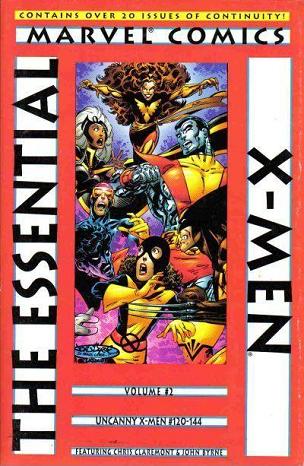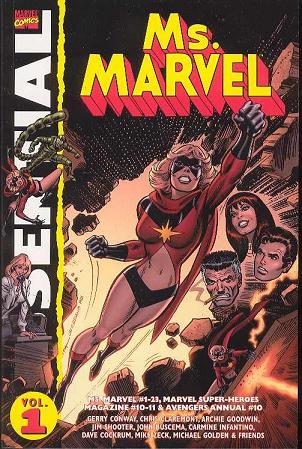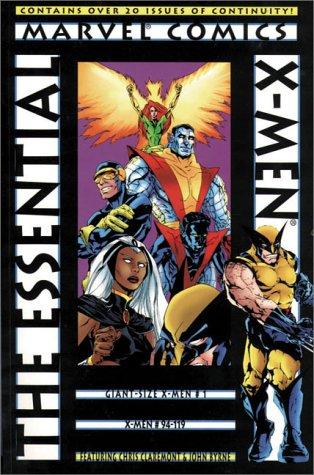
Essential Essential X-Men Vol. 2
Chris Claremont, John Byrne and friends
Reprints: Uncanny X-Men #120-144 (April 1979 – April 1981)
Get this for: Byrne and Claremont at their peak together — five stars
Essential X-Men Vol. 2 contains the first X-Men comics I had ever read, which was also one of the very few superhero stories that ever gave me nightsmares: X-Men #141-142, “The Days of Future Past”. It’s the story in which the X-Men found the nemesis they would be fighting for the next two decades, the inevitable future that would await them if they slipped up, that for all their victories they might not be able to prevent happening. It’s a great story, perhaps the best Byrne and Claremont ever did together and it captured the essence of the X-Men.
And here it comes at the end of a great run of stories. While the first volume saw Claremont still finding his feet, here both he and John Byrne are fully in control and confident of their craft. The volume starts with the last leg of the X-Men’s world tour that had begun in the previous collection, as the X-Men run into Alpha Flight attempting to take back Wolverine into the Canadian secret service. This followed by their first match against Arcade, the murderer for hire who likes to kill his victims by funfair. Barely recovered from these fights, they discover Jean Grey, whom they had thought had died in the climatic fight against Magneto a dozen issues or so again, was still alive and kicking at Muir Island, but menaced by a new menace: Mutant X. Defeating him turns out to be the heaviest fight and costliest victory they have known yet, but that’s just the start.
Now things kick into high gear, as professor X is back, two new mutants, Kitty Pryde and the Dazzler are found and turn out to be bait in a trap a new group of villains, the Hellfire Club, has set. Meanwhile this same club turns also be behind a long running subplot in which Jean “Phoenix” Grey has had multiple flashbacks to the live of one of her ancestors, which turns out to be the result of manipulation by Mastermind, in order to recruit her for the Club. The X-Men manage to defeat the Hellfire Club in their first encounter, go on offensive but this turns into tragedy as Jean Grey is indeed turned to the dark side, so to speak. Their second clash with the Hellfire Club sets in motion two new menaces, one longterm as senator Robert Kelly is confirmed in his suspicions about the X-Menb and mutants in general, the second an immediate threat as Mastermind’s manipulations awaken Jean Grey’s cosmic powers and she turns into the evil Dark Phoenix.
The Dark Phoenix Saga is the end point of more than two years of stories and subplots coming together, as Jean’s powers ultimately consume her in one of the most moving issues in the entire X-Men run. Reading these stories in one sitting, all the way from the still fairly mundane fight with Alpha Flight in #120 to the end of Phoenix in #137, you can see how Claremont and Byrne slowly but relentlessly speed up the action and danger until at the end the X-Men have no breathing space whatsoever going from one menace to another. Whereas other heroes, other teams might get some time to savour their victories, the X-Men never get to catch their breaths until it is too late. Even after the climax of the Dark Phoenix saga, there’s only one issue of recaps and half an issue of Kitty’s introduction to the X-Men before the race starts again. First it’s Wolverine and Nightcrawler up in Canada helping out Alpha Flight with Wendigo, then as said, it’s “Days of Future Past”.
Now from the start the X-Men had had as their hook, the thing that made them unique, that they were mutants, heroes different from normal people not through some unlucky accident, study of magic or high tech battlesuits, but because of what they were born with. For a long part this aspect, that they were supposed to be the team that made mutants acceptable to a world that might otherwise hate and fear them, was only paid lipservice to, the occasional Sentinel appearance not withstanding. Under Claremont this aspect had become more prominent, but it was only with “Days of Future Past”, which showed a nightmare future in which the X-Men had not succeeded in their mission and the Sentinels had wiped out most mutants and taken over the world, that this became the cornerstone of the series. With the original X-Men, all that suspicion and fear people felt was just a typical Lee shtick to handicap his heroes: here it became something real and tragic. You could call it a metaphor for racial or sexual prejudice, or more cynically, a metaphor for adolescence, but this is a metaphor made concrete: in the end it is a story about how we might react to the discovery of a mutant race of superpowered beings living amongst us…
That delayed future would become everything the X-Men fought against, though it was still some time away before it would really dominate the series — we must also remember that basically this future denies the very reason of the X-Men’s existence. As long as it is still a possible outcome, it means that all their victories are hollow…
Back to the current volume, the “Days of Future Past” is followed by a perfect one issue story, as Kitty Pryde takes on a demon that does looks nothing like the Alien from the Sigourney Weaver movies at all, uh huh. It’s a textbook example of an “outmatched hero uses the environment and her brains to defeat her almost invincible foe” story. This is followed by another one issue story, a solo Cyclops story following his adventures after he left the X-Men what with Jean’s dead and all, which ends the volume.
That last story is the only one not to feature Byrne on the art. It’s not always easy to appreciate him, what with the great volume of mediocre work he has done since X-Men, but he starts great and keeps getting better each issue. You understand why he set the style for at least one generation of superhero artists. He takes the best aspect of the Marvel Housestyle of the seventies, that clear, easy to follow style of layout and drawing that means you can immediately understand what’s happening on any page and puts it together with his own flair for composition and figure drawing. His work is always in the service of the story but he always makes it look good as well. He has that knack that so few artists have, of not only making you see the world in his art, but seeing the world through his art. Reading a huge chunk of his work in one go like this means I will see Byrne poses everywhere for the next few days.
A small sacrifice.


